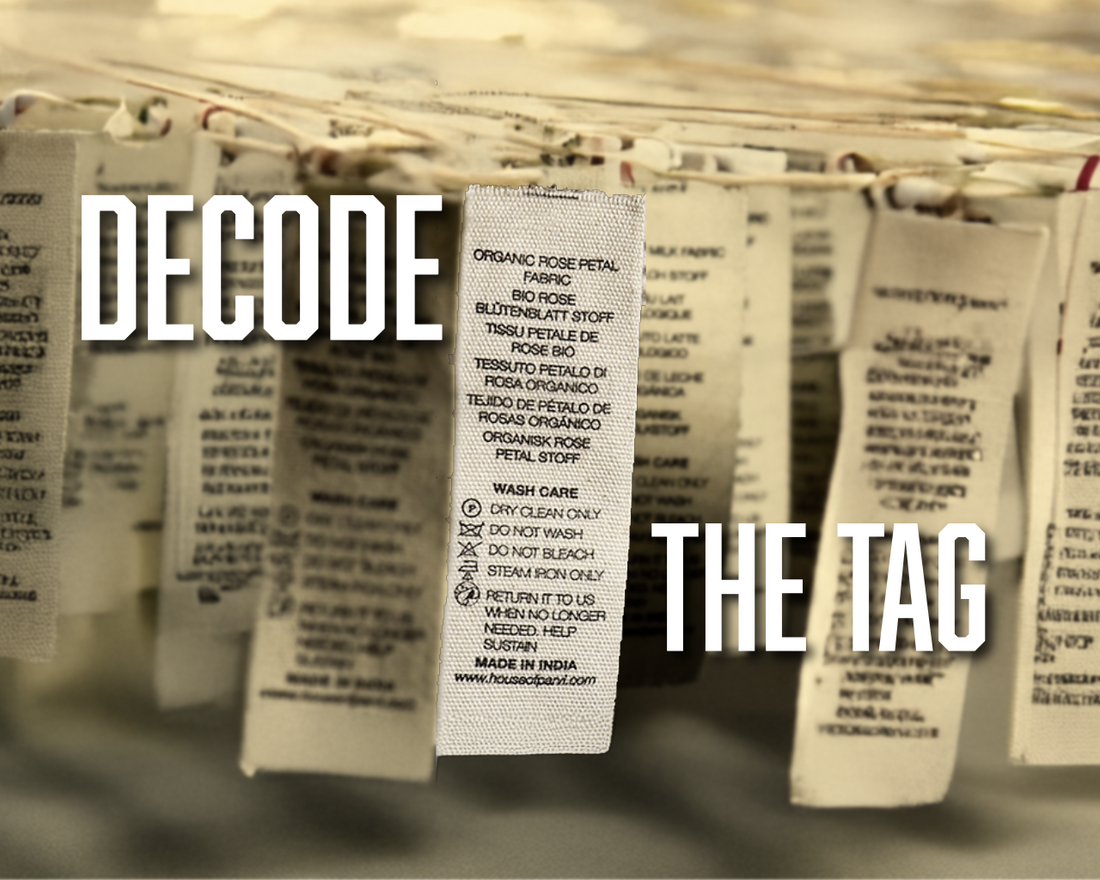
5 Ways to Read a Clothing Label Like a Conscious Shopper
Share
Before you fall for a color or a cut, there’s one tiny detail that reveals the truth about what you’re buying — the label inside.
Most of us barely notice it. But that small tag has all the answers: what your garment is made of, who made it, how to care for it, and whether it’s kind to the planet.
Think of it as your sustainability cheat sheet — here’s how to read it like someone who shops with intention, not impulse.

Why it matters:
The fabric defines everything — comfort, durability, breathability, and most importantly, its impact on the planet. Natural and plant-based fabrics biodegrade; synthetics don’t.
Many garments combine natural and synthetic fibers — for example, 60% cotton, 40% polyester. Blends can improve texture, stretch, or wrinkle resistance, but they also make recycling harder and slow down biodegradation. When natural fibers are mixed with synthetic ones, that “eco” fabric can’t fully biodegrade.
If you spot a blend, ask:
-
Is the blend serving function (like durability)?
-
Or is it cutting costs?
-
Does the brand explain why it chose this composition?
The more transparent the explanation, the better the choice usually is.
Red flags:
-
Vague phrases like eco-blend or sustainable fabric with no details.
-
Long fiber lists full of “poly,” “nylon,” or “acrylic.”
-
No mention of the blend ratio — it should always total 100%.
Tip: A Fashion Revolution study found nearly 40% of clothing labels misrepresent fiber content. So it’s worth reading carefully — and trusting brands that are open about their material story.

Here’s what they mean in plain words:
-
GOTS (Global Organic Textile Standard): Covers both organic material and fair labor practices.
-
OEKO-TEX Standard 100: Ensures the fabric is tested for harmful chemicals.
-
Fair Trade Certified: Supports ethical wages and working conditions.
-
PETA-Approved/Vegan: Confirms no animal-derived components.
-
B Corp: Indicates broader company-wide social and environmental responsibility.
Each one tells you a part of the story — from fiber purity to people’s welfare.
Red flags:
-
Labels saying “ethically made” or “eco-friendly” without a certification mark or traceable report.
-
Certificates that look unfamiliar or aren’t verifiable online.
Decode the Care Symbols — Because Care = Longevity

Why it matters:
Clothing longevity is sustainability in action. Every wash cycle affects color, texture, and microplastic shedding. Reading those symbols is one of the simplest ways to make your clothes — and your choices — last.
Red flags:
-
Missing or unclear symbols — it usually signals lower-quality production or lack of testing.
-
Instructions that contradict the fabric type (e.g., “machine wash hot” on delicate silk).

It’s not about judging countries — it’s about traceability. The best brands openly share where and how their pieces are made. Some even include factory codes, batch numbers, or QR links that let you see the journey from fiber to finish.
Why it matters:
Transparency builds trust. When a brand tells you who made your garment, it’s taking responsibility — for fair labor, safe production, and ethical trade.
Red flags:
-
Labels that only mention “Designed in X” but hide manufacturing origin.
-
No production details or contact info at all.
Watch for Greenwashing — The Language of Vagueness
Some brands use the right words for the wrong reasons.

Real sustainability is traceable — not trendy.
Red flags:
-
Vague sustainability promises with zero proof.
-
Overuse of nature imagery and buzzwords without substance.
-
Brands that market a “conscious collection” while producing thousands of fast-fashion drops.
Quick check: Does the brand publish how it sources fabrics, who makes its garments, or how it reduces waste? If not — the green is just for show.

Learning to read it is like learning a new language — the language of conscious living.
And once you speak it, shopping will never feel the same again.

